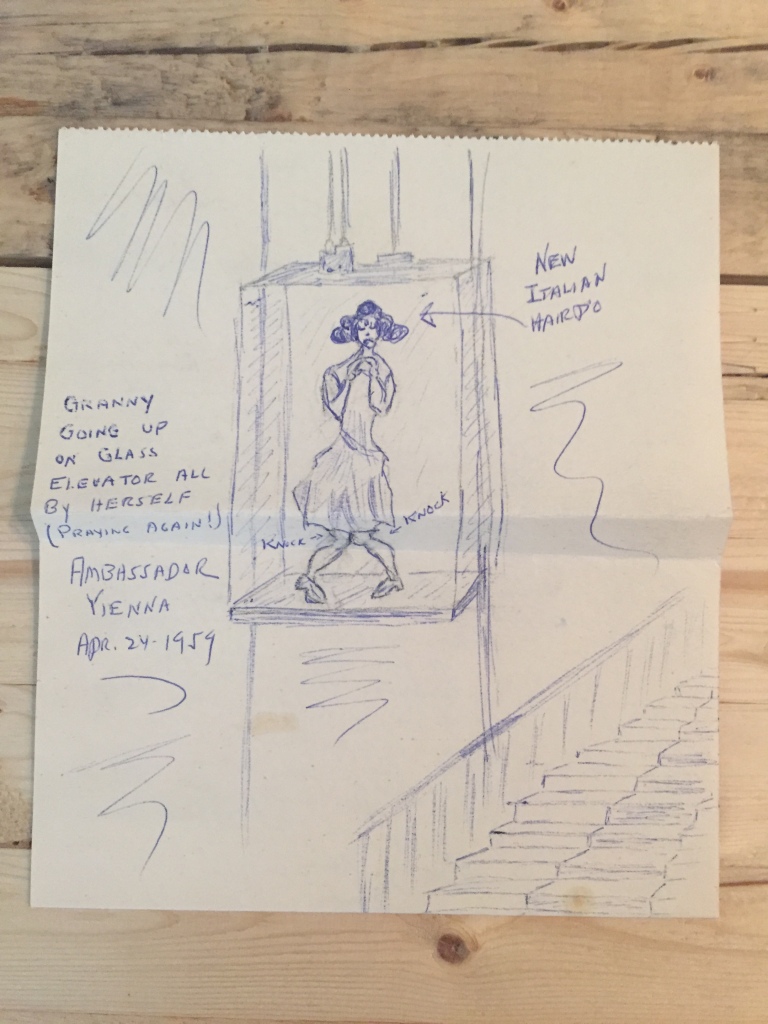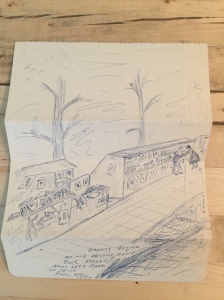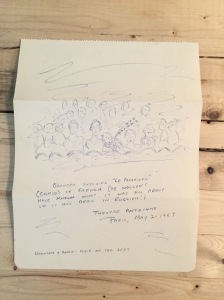
At the start of the summer of 2010, when my wife was pregnant with our daughter, I sent out an email to everyone I know: Hey, I need work. I’ll do anything. Got any ideas?
The boss of my sister-in-law (yes, that one) responded: I have a ranch that’s overgrown and needs tending. The work is literally backbreaking, but if you’re interested meet me at the Wal-Mart on 71 tomorrow at 6 am and we’ll drive out there.
He needed someone to clear the land of cedar, agarita, and cactus, to make it better grazing for cattle and to help the grass and the oak trees thrive. So that’s what I’ve done for basically the entire course of my PhD program, at every summer and winter break, and odd weekends in the fall and spring. Though I’ve done some of the work with a chainsaw, the majority has been done with stone-age tools: a shovel, an ax, a pick. I chop the cedar trees, hack the agarita from under its roots, and dig out the cactus with a shovel. Then I throw it all into the back of the twenty-five-year-old Chevy I borrow from my boss and drive it to piles to be burned later. Sometimes I get to burn those piles; sometimes, for a “break,” I get to do odd jobs around the 150-year-old ranch house, like paint the trim or fix the doors on the toolsheds when they’ve warped.

In a real sense, this blog grew up around my work out there. When I first started working at the ranch, gay marriage and contraception were hot topics, and my conservative Catholic friends on Facebook were debating and pointing me to blogs and articles, and I was getting into long combox debates about the subject. At home in Austin I’d print out the blog posts and articles from journals like First Things and The Public Discourse, and I’d check out the books they’d recommend, and I’d take them along with me to the ranch to read during my water-breaks. Then I’d scribble my responses in a notebook I kept with me in the truck. Sometimes, if I was feeling hot enough about what I had to say, I would drive into town (30 minutes away) during my midday break, head to Fredericksburg Coffee & Tea (which has free wi-fi), order an iced tea, and post it right away. Usually, though, I would wait until I got back to Austin.
In 2012, I got tired of writing the same things over and over again, and so I decided to start this blog, where I could post these arguments once and then just point people here when, for example, they’d bring up the incest argument or the food/sex analogy. But my composition process stayed the same: I did most of my thinking while I worked, and most of my reading and writing from the ranch pickup truck or the kitchen table in the ranch house. And I posted most of my arguments having just come from the ranch, often with ranch dirt and cedar needles still ground into my jeans.
What that means is that a lot of the arguments I’ve come up with have literally been composed to the rhythm of tree-chopping, or while dragging brush across a field. Which I think matters because, often, the underlying subject in these debates is nature. What is natural? Is homosexuality natural? Can gay marriage be natural? What does nature have to say about these things?
And, often, I’ve been flabbergasted at the distance between the “nature” described by the First Things/Public Discourse crowd and what I actually see before me, around me, under my feet, and above my head at the ranch. What I see in their writing is a universe whose order is easily apprehended: in which everything is as it seems, in which you never have to grapple with exceptions, in which you can be comfortable in your certainty and never worry about changing your mind. What I’ve seen at the ranch is the opposite.
That’s why, I think, the ranch has proven such fertile ground for this blog. That discrepancy makes me want to write, makes me want to argue, and makes me want to reclaim a word, nature, that matters to me and that I think these guys drain of all of its meaning and majesty.

——
Take this recent post by Anthony Esolen at Life Site News. Now, it’s Esolen, so a lot of the writing is good. Like this sentence:
I am persuaded that we could clear our heads of most of the unnatural evils we have come to accept if we would simply leave the Teaching Machine and the Entertainment Machine, and go out of doors, and stay there for a while, walking, listening, perhaps whistling, playing, working, thinking, or simply being.
Lovely, and true. But, as Esolen always does, he ruins it with a bitter note that’s both ugly and factually wrong:
Or you are in the field, working, wiping on your sleeve the sweat from your brow and brushing away the gnats. The hay has to be made. The silly feminist who declares that fairy tales are evil – she has never had to make the hay. Most things that most people fret about, and most of the unnatural states they imagine themselves into, vanish into the vanity they are when you have a field, mown grass everywhere, and hay to make. Your very muscles will rouse you back into reality.
I mean, I don’t think fairy tales are evil or anything, but Esolen would still probably consider me a silly feminist. And yet I’ve wiped plenty of sweat off my brow in the fields.
Esolen tries to enlist nature to his side of the culture war by tying things he doesn’t like (gay marriage and feminism), to things that are clearly bad and unnatural: fluorescent lights, rushed lunches, consumerism, Justin Bieber. That’s bad enough, but I want to focus on his conclusion:
Our opponents claim the unnatural. Let them. Nature is on our side, and she does not change.
Nature doesn’t change? Sure. But so what? That’s the wrong lesson to take from her. We’re humans: we operate on a much smaller scale. So we need to be humble in reckoning our knowledge of her, careful before claiming certainty, and always ready to learn something new about her. We need to be prepared to accept that our understanding of nature can change.
To wit:
The summer of 2011 in Texas was the hottest any state has ever recorded in the US, with more than 100 days over 100 degrees.
I remember well what it was like to be in that moment. Rain was inconceivable, a rumor, something less than a memory. I watched the grass turn from brown to yellow and then to white, and even the cedars were losing their color. I was sure, that summer, that I was watching the Chihuahua desert swelling up from Mexico and swallowing the Edwards Plateau.
There’s an Elmer Kelton book with a title that captures that summer: The Time it Never Rained. I love that title: it gets at both the sense that what we understand now is what will always be, and the folly in believing that sense, in taking that momentary idea of the infinite as something actually infinite. Because the last time I was at the ranch, this past August, it was green. Unbelievably, there were flowers in the fields, that late in the year. Believe it or not, I woke one morning to a cool breeze.
This is what nature teaches you, over and over again: you are wrong. What you think will last will not last. What you think is certain is not certain. Arizona was once underwater; Scotland once had a tropical climate. Esolen is right: nature doesn’t change. But it always surprises, because, as a gifted poet puts it, “The trouble, obviously, is that we do not know much of the truth.”

——
I don’t want to give the impression that all I do in my free time at the ranch is work on this blog. I have lots of time to myself there, and the blog only fills up a small part of it. I did most of my reading for comprehensive exams at the ranch, and I’ve written big chunks of my dissertation there, too. And I always keep a book of poems and a book of essays in my bag for pleasure reading.
One writer whose books are often in my bag also happens to be a guy whose view of nature matches what I see when I’m out there: Wendell Berry.
When asked by interviewer Sarah Leonard about persistent themes in his writing, Berry responded:
‘Wonder’ is a word that applies. To live and work attentively in a diverse landscape such as this one—made up of native woodlands, pastures, croplands, ponds, and streams—is to live from one revelation to another, things unexpected, always of interest, often wonderful. After a while, you understand that there can be no end to this. The place is essentially interesting, inexhaustibly beautiful and wonderful.
That wonder often appears in Berry’s writing, especially his poetry, in moments of sudden revelation, where beliefs are upended, even reversed. A tree falls: the world is changed. Married for decades, a couple discovers they have continents worth of knowledge to discover in each other. I mentioned before the poem “Breaking,” from The Country of Marriage, in which the speaker compares his previous beliefs to water flowing over ice. The speaker concludes: “And now / that the rising water has broken / the ice, I see that what I thought / was the light is part of the dark.”
That sudden change, that sense of reversal, is exactly what one feels on reading his essay “Poetry and Marriage: the Use of Old Forms.” That’s what I was trying to get at last week: Berry traces a systematic argument about poetic form and then, we could almost say miraculously, finds a way to accommodate a poet (Walt Whitman) who violates the central principle of that argument. And he does it not begrudgingly but cheerfully, as if making a discovery: Wow. The world is bigger than I imagined.
This sense of wonder might just be how Berry can come to support a phenomenon that Esolen swears to us is impossible in nature. “Whoever really has considered the lilies of the field or the birds of the air,” Berry writes, “and pondered the improbability of their existence in this warm world within the cold and empty stellar distances will hardly balk at the turning of water into wine – which was, after all, a very small miracle.”

——

I’ll end with a story from the ranch, and one more connection to Berry. I don’t tell this story often, because it seems too small to be worth sharing. But it fits here, so here goes:
I was working one afternoon at the edge of the south field, clearing away brush and small cedars from a tangled, overgrown oak grove. Chopping away at a cedar, I noticed something moving behind me. When I turned, I saw a tiny green grass snake on the stump of the tree I had just cleared. He was just watching me. Not hiding, not tense, his head raised up, just looking. He kept watching as I finished with the tree and moved on to the next. He watched me for a solid ten minutes, and then he slithered off, finally bored I guess, and I moved on to another group of trees.
Understand, this snake was well within the reach of my ax. Everything I know about nature and about snakes told me he should be wary of me. But he wasn’t. And when I turned to him, he didn’t flinch or skitter off. He just kept watching. He just seemed curious.
Now, I’ve seen more exciting animals at the ranch, had more dramatic encounters with people and beasts. But that one has stuck with me for some reason, probably involving the way that it challenged my idea of the ways nature works.
I feel less silly telling it, though, because I recently read Berry’s essay “Getting Along with Nature” (1982), in which he tells a similar story:
At the end of July 1981, while I was using a team of horses to mow a small triangular hillside pasture that is bordered on two sides by trees, I was suddenly aware of wings close below me. It was a young red-tailed hawk, who flew up into a walnut tree. I mowed to the turn and stopped the team. The hawk then glided to the ground not twenty feet away. I got off the mower, stood and watched, even spoke, and the hawk showed no fear. I could see every feather distinctly, claw and beak and eye, the creamy down of the breast. Only when I took a step toward him, separating myself from the team and mower, did he fly. While I mowed three or four more rounds, he stayed near, perched in trees or standing erect and watchful on the ground.
Berry goes on to ask, “Why had he come? To catch mice? Had he seen me scare one out of the grass? Or was it curiosity?”
Like me, even Berry feels sheepish about sharing his story. “In some circles,” he writes, “I would certainly be asked if one can or should be serious about such an encounter, if it has any value.” But, he concludes, “I would unhesitatingly answer yes.” And he goes on: “Such encounters involve another margin—the one between domesticity and wildness—that attracts us irresistibly; they are among the best rewards of outdoor work and among the reasons for loving to farm.”
The behavior of Berry’s hawk, and my snake, reminds me of his exhortation, in “Manifesto: The Mad Farmer Liberation Front,” to “every day do something / that won’t compute.”
In telling his readers to do that, he’s not arguing that they should act against their nature—he’s telling them that’s what their nature is: a world full of surprises and contradictions.
The truly gorgeous thing about this is that it doesn’t require us to get rid of what we know. It’s a process of addition. I would be stupid to say, on the basis of my encounter on the ranch, that animals, or snakes, or tiny green grass snakes, have no instinct for self-preservation. But I also can’t deny that that instinct isn’t always the governing force for a snake’s behavior. To deny what I’ve seen, just because it challenges what I already knew, would be just as stupid.
Berry finds this process of addition fascinating, and so do I. I get to live in a world where, if I want to be truthful, I have to say a) snakes will do whatever they can to preserve their own lives AND b) sometimes a snake will risk his life to watch you chop down a tree. A world like this is truly a world of infinite possibility. “You cannot leave anything out of mystery,” Berry writes, “because by definition everything is always in it.” Recognizing this, I think, is truly a way of approaching the divine.
But this is precisely where (I think) Berry loses some of his biggest fans—and it’s where our conversations about nature tend to fall apart. You cannot leave anything out of mystery. That is a radical sentiment. And not everyone is willing to take it seriously.

 Anthony Esolen’s recent article at Crisis, “What Would Our Ancestors Think of Us?” is, well, classic Esolen. He starts by comparing modernity to an open sewer, then imagines a conversation between a modern time-traveller and his ancestors, who despair at the state of things in 2016. “How then shall we live?” Esolen imagines them asking.
Anthony Esolen’s recent article at Crisis, “What Would Our Ancestors Think of Us?” is, well, classic Esolen. He starts by comparing modernity to an open sewer, then imagines a conversation between a modern time-traveller and his ancestors, who despair at the state of things in 2016. “How then shall we live?” Esolen imagines them asking.













